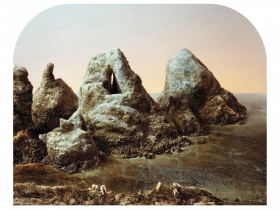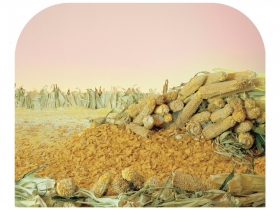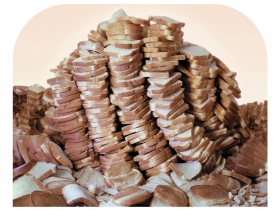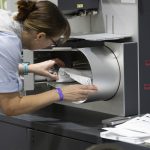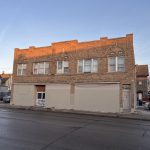We Are What We Eat
MOWA show creates weird American landscapes made of junk food.
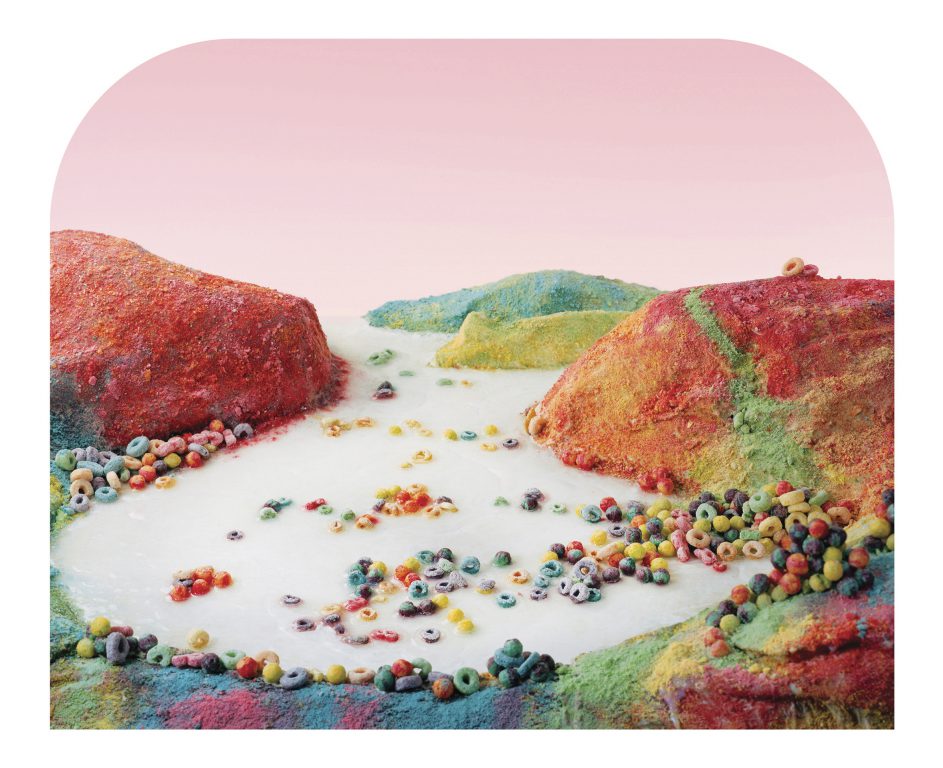
Fruit Loops Landscape, from the series Processed Views: Surveying the Industrial Landscape, 2012-2014 by Barbara Ciurej & Lindsay Lochman
The show is colorful, funny and edgy with classic images of the the 19th century American West landscapes reimagined as processed food loaded with artificial ingredients, arranged to look like nature formations. It’s called Processed Views: Surveying the Industrial Landscape, and is now on display at the Museum of Wisconsin Art’s space at St. John’s on the Lake, 1840 N. Prospect Ave., through October 8.
The exhibit features the ingenious work of photographers and longtime collaborators, Milwaukee resident Lindsay Lochman and Chicagoan Barbara Ciurej. The exhibit questions the modern-day advertising industry, the dangerous appeal of convenience foods, and the long-term environmental effects of mass-scale agriculture.
Ciurej and Lochman’s archival pigment prints, created between 2012 and 2014, echo the work of early landscape photographer Carleton Watkins, whose photos depicted the West as an area not only of rich natural beauty, but of seemingly boundless opportunity. The photographers’ mass-produced food subjects are certainly plentiful, but anything but natural — high in fat, sodium and sugar.
The photographers’ compositions are textured and imaginative, and their color schemes, although somewhat monochromatic, are eye-catching — like actual nature formations.
In “Fruit Loops Landscape” bits of Fruit Loops cereal float in a river of milk, surrounded by rainbow-hued bluffs made of crushed Trix cereal. “Deep Fried Bluffs” portrays mounds of golden French fries and shoestring potatoes set against a shore of Oscar Mayer bacon on a lake of lard.
“Blue Dye #1 Precipice” (Duncan Hines’ Blue Velvet Cake Mix and Budget Saver Monster Pops) is particularly striking, featuring a towering mass of bright blue layer cake as background, with fluorescent green frozen treats possibly representing plants or tall grass.
“Monoculture Plains,” offers piles of cornmeal, Corn Flakes, corncobs and corn husks, forming what appears to be a barren plain, suggesting the devastating effect industrial farming can have on soil nutrients.
Processed Views includes Enhanced Varieties: Seduction in the Land of Plenty, about a dozen reproductions (colored with Jell-o) of a single Watkins silver gelatin print of a crate of peaches. Taken in the 1880s, this photo was intended to represent Kern County, California, as a sort of Shangri-La of prosperity and fertile crops (never mind the state’s arid climate). Even back then the public could fall prey to the irresistible charms of the marketing industry.
“Sugar Geology: Igneous, Metamorphic and Sedimentary,” is a 2017 series of “rock formations” Ciurej and Lochman created out of candy (bringing to mind the children’s song, “Big Rock Candy Mountain”) and gum. A description on the exhibit reads: “The transformative forces of compression, crustal deformation and deposition of sediment reflect alterations that may also occur when applied to human biology.”
Most of us realize, of course, that convenience foods aren’t good for us. But viewing these works brings that home in a new way. Processed Views illustrates that these foods are a part of America’s nutritional landscape–just like our mountains, lakes, bluffs and rivers are a part of our environmental landscape.
Processed Views: Surveying the Industrial Landscape Gallery
If you think stories like this are important, become a member of Urban Milwaukee and help support real independent journalism. Plus you get some cool added benefits, all detailed here.
Art
-
It’s Not Just About the Holidays
 Dec 3rd, 2024 by Annie Raab
Dec 3rd, 2024 by Annie Raab
-
After The Election Is Over
 Nov 6th, 2024 by Annie Raab
Nov 6th, 2024 by Annie Raab
-
The Spirit of Milwaukee
 Aug 30th, 2024 by Annie Raab
Aug 30th, 2024 by Annie Raab
Review
-
Eating Burmese in Bay View
 Dec 13th, 2025 by Cari Taylor-Carlson
Dec 13th, 2025 by Cari Taylor-Carlson
-
Casablanca Is a Milwaukee Success
 Nov 30th, 2025 by Cari Taylor-Carlson
Nov 30th, 2025 by Cari Taylor-Carlson
-
Oh, Those Witty 18th Century Brits
 Nov 24th, 2025 by Dominique Paul Noth
Nov 24th, 2025 by Dominique Paul Noth



